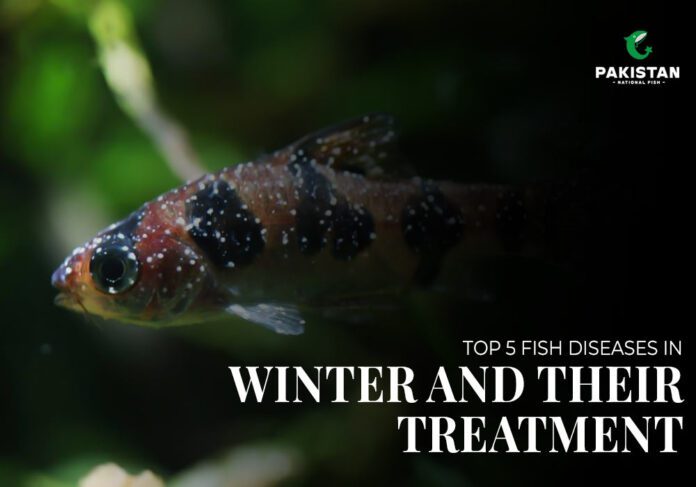Just like the human body, fish too are prone to various fish diseases during the winter season, whether they are in a pond or an aquarium. This vulnerability arises because their metabolism slows down gradually, and their immune system becomes less effective in the cold weather.
Whenever there are complications with a fish tank, bacterial infections, fungi, or even parasitic infestations pop up during this season, and as such, fishkeepers have questions such as what can be done to treat bacterial infection in fish tanks or are there fish diseases that are transmissible to humans?
Fish Diseases in winter
• Columnaris Infection Or Bacterial Infection
Columnaris, which occur when affected by Flavobacterium columnare bacteria, is a problem freshwater aquarium fish develop during the winter months. They prefer water with comparatively low dissolved oxygen concentrations and these are evident where water temperature is high or where water stagnation is rife. This creates simple-minded questions such as ‘Is there more dissolved oxygen in cold or warm water?’ That said, the answer is cold water can dissolve more oxygen allowing fish to live in a healthy state.
Symptoms:
- Small white lesions particularly on the flanks or scattered whitish spots on the lateral line or fins.
- Frayed fins and tail
- Open sores or ulcers
- These are behavioral changes that may include sleeping and floating sporadically at the water’s surface.
Treatment:
- Raise the water oxygen level through the use of an air pump or tank filter.
- Sequally quarantine the affected fish to reduce the spread of infection.
- For bacterial disease in fish give oxytetracycline or kanamycin when needed.
Also, the water needs to be tested for quality and should be changed frequently to enhance the fish’s well-being.
• White Fungus In Fish Aquariums
Fungal diseases are characterized by white, fluffy discharges in various parts of the fish’s body, mouth, and/or fins. These infections develop particularly after an injury or after a bacterial problem, such as goldfish bacterial disease or goldfish mouth fungus.
Symptoms:
- White to the slightly gray fuzz on skin, fins, and/or gills.
- Sluggish behavior
- Loss of appetite
Treatment:
- Get rid of the sick fish and move it to a separate tank that you’ll use to treat the disease.
- Chemotherapy agents applied as antifungal agents comprise methylene blue or malachite green.
- Make sure you filter the water and must also make sure that the water is at the right temperature.
- Please do not feed them very often as this leads to organic wastes accumulating and this can cause stretched-out areas of their skin to develop fungal attacks.
• Red Spot Disease
Red spot disease is also known as Aeromonas infection and is a bacterial disease that leads to ulceration of different parts of the fish’s body. This disease is worse during winter since the immune system of the fish will be affected.
Symptoms:
- Red, inflamed spots or ulcers
- Enlargement of the tissues in the size of the affected areas
- Vocalizations, specifically, fast swimming, or staying still for long periods
Treatment:
- The recommended fish bacterial infection treatment should be through the use of antibacterial medications meant for fish.
- Clean the tank properly and always keep the conditions of the water proper.
- Offer the fish a balanced diet in order to enable the immune system of the fish to improve.
- If your fish manifests severe signs of the disease, seek a vet who specializes in treating freshwater aquarium fish diseases.
• Whirling Disease
Whirling disease impacts only young fish and is transmitted by a parasite known as Myxobolus cerebralis. This disease interferes with swimming and when they swim, they swim like they are corked, spiraling round and round. Although more prevalent in outdoor common ponds, it may also occur in aquarium systems.
Symptoms:
- Disordered swimming, especially when swimming in circles (in the shape of a corkscrew or continuously whirling round and round).
- Darkened tail area
- It leads to skeletal deformities; in severe instances.
Treatment:
- Any infected fish should quarantined as soon as feasibly possible to keep the organism from spreading to the other fish.
- Clean out & disinfect the tank.
- Do not put any wild-caught fish into your aquariums without first isolating them in a quarantine tank.
- Treat for parasites according to advice from an aquatic veterinarian.
• Fish Tank Granuloma
Aquarium fish tank granuloma is a chronic bacterial disease that results from an infection with Mycobacterium marinum. In turn, it calls the question “Can fish diseases be passed to humans?” as the latter is not only dangerous for fish but for humans as well.
Yes, in this case, fish tank granuloma can cause infection in humans just in case they are involved in raw water and they get involved in an open wound.
Symptoms:
- Weight loss and emaciation
- Skin ulcers or nodules
- Lethargy
Treatment:
- Even though individual fish constituting a school maintain a certain distance from other schools, affected fish should be picked and euthanized to contain the spread of the disease.
- For me, it is a must to clean the tank as well as equipment with disinfectant.
- In case a farmer decides to use Antibiotics, he or she should do so under the recommendation of a veterinarian.
- While handling infected fish or cleaning the tank it is recommended that you wear gloves so that you do not get infected.
How to Prevent Winter Fish Health Issues
1. Maintain Optimal Water Quality
Analyse water parameters often for pH, Ammonia, Nitrites, and Nitrates.
Partial water changes must be done regularly especially on a weekly basis to avoid accumulated hazardous content in the aquarium.
2. Ensure Proper Aeration
Buy an air pump or additional filter to keep oxygen production at optimum quality.
Cold water sources contain more dissolved oxygen than warm water, although low levels of dissolved oxygen may occur if the water does not circulate well.
3. Provide a Balanced Diet
This makes them immune to diseases, by taking them through regular feeding with quality and well-balanced diets.
Do not overfeed your pet, some food leftovers can ferment and therefore contaminate the water.
4. Quarantine New Fish
It is always advised that beginner fishermen should isolate new fish for not less than 14 days before introducing them to the aquarium.
Pay close attention to the symptoms of freshwater aquarium fish diseases during this period.
5. Monitor Temperature
A good heater should be used in aquariums to enable proper regulation of its temperature.
They are sensitive to accelerated changes in temperature, and the fluctuations leading to diseases are likely to affect the fish.


